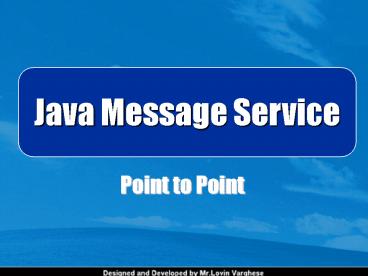Java Message Service PowerPoint PPT Presentation
1 / 27
Title: Java Message Service
1
Java Message Service
Point to Point
2
Point To Point Architecture
3
Overview
JMS PTP is common for a client to have all its
messages delivered to a single queue. The JMS
PTP model defines how a client works with queues.
How it finds them how it sends messages to
them and, how it receives messages from them.
4
JMS Objectives
JMS defines a common set of enterprise messaging
concepts and facilities. JMS attempts to
minimize the set of concepts a Java language
programmer must learn to use enterprise messaging
products. JMS strives to maximize the
portability of messaging applications. A major
goal of JMS is that clients have a consistent API
for creating and working with messages which is
independent of JMS provider.
5
Queue Management
Queue A Queue object encapsulates a
provider-specific queue name. It is the way a
client specifies the identity of queue to JMS
methods. QueueConnection A QueueConnection is
an active connection to a JMS PTP provider. A
client uses a QueueConnection to create one or
more QueueSessions for producing and consuming
messages.
6
Queue Management
QueueConnectionFactory A client uses a
QueueConnectionFactory to create QueueConnections
with a JMS PTP provider. QueueSender A client
uses a QueueSender to send messages to a queue.
7
Queue Management
QueueReceiver A client uses a QueueReceiver
for receiving messages that have been delivered
to a queue. If a QueueReceiver specifies a
message selector, the messages that are not
selected remain on the queue. By definition, a
message selector allows a QueueReceiver to skip
messages. This means that when the skipped
messages are eventually read, the total ordering
of the reads does not retain the partial order
defined by each message producer.
8
Queue Management
TemporaryQueue A TemporaryQueue is a unique
Queue object created for the duration of a
QueueConnection. It is a system defined queue
that can only be consumed by the QueueConnection
that created it. QueueBrowser A client uses a
QueueBrowser to look at messages on a queue
without removing them. The browse methods
return a java.util.Enumeration that is used to
scan the queues messages.
9
Queue Management
QueueSession A QueueSession provides methods
for creating QueueReceiver's, QueueSender's,
QueueBrowser's and TemporaryQueues.
10
Eleven Steps to PTP JMS Sender
(1) Get the InitialContext (2) Get hold of
the ConnectionFactory. (3) Make Queue
connection from the Connection Factory
object. (4) Create a Queue Session from the
Queue Connection object. (5) Get connected to
the Queue (HelloQueue) (6) If Queue does not
exists then create a queue called
HelloQueue (7) And bind to the Context (8)
From the session object create QueueSender
object (9) Start sending the message
11
Relationship to Other JavaSoft Enterprise APIs
(1) Get the InitialContext
private static InitialContext getInitialContext(S
tring url) throws NamingException
Hashtable env new Hashtable() env.put(Conte
xt.INITIAL_CONTEXT_FACTORY, JNDI_FACTORY) env.pu
t(Context.PROVIDER_URL, url) return new
InitialContext(env)
12
Relationship to Other JavaSoft Enterprise APIs
(2) Get hold of the ConnectionFactory
QueueConnectionFactory qconFactory
(QueueConnectionFactory) ctx.lookup(javax.jms.Que
ueConnectionFactory)
13
Relationship to Other JavaSoft Enterprise APIs
(3) Make Queue connection from the Connection
Factory object.
QueueConnection qcon qconFactory.createQueueCon
nection()
14
Relationship to Other JavaSoft Enterprise APIs
(4) Create a Queue Session from the Queue
Connection object
QueueSession qsession qcon.createQueueSession(f
alse, Session.AUTO_ACKNOWLEDGE)
15
Relationship to Other JavaSoft Enterprise APIs
(3) Make Queue connection from the Connection
Factory object.
QueueConnection qcon qconFactory.createQueueCon
nection()
16
Relationship to Other JavaSoft Enterprise APIs
(3) Make Queue connection from the Connection
Factory object.
QueueConnection qcon qconFactory.createQueueCon
nection()
17
Relationship to Other JavaSoft Enterprise APIs
(3) Make Queue connection from the Connection
Factory object.
QueueConnection qcon qconFactory.createQueueCon
nection()
18
Relationship to Other JavaSoft Enterprise APIs
(3) Make Queue connection from the Connection
Factory object.
QueueConnection qcon qconFactory.createQueueCon
nection()
19
Relationship to Other JavaSoft Enterprise APIs
(3) Make Queue connection from the Connection
Factory object.
QueueConnection qcon qconFactory.createQueueCon
nection()
20
Relationship to Other JavaSoft Enterprise APIs
(2) Get hold of the ConnectionFactory
QueueConnectionFactory qconFactory
(QueueConnectionFactory) ctx.lookup(javax.jms.Que
ueConnectionFactory)
21
Eleven Steps to PTP JMS Sender
(1) Get the InitialContext (2) Get hold of
the ConnectionFactory. (3) Make Queue
connection from the Connection Factory
object. (4) Create a Queue Session from the
Queue Connection object. (5) Get connected to
the Queue (HelloQueue) (6) If Queue does not
exists then create a queue called
HelloQueue (7) And bind to the Context (8)
From the session object create QueueSender
object (9) Start sending the message
22
Relationship to Other JavaSoft Enterprise APIs
(2) Get hold of the ConnectionFactory
QueueConnectionFactory qconFactory
(QueueConnectionFactory) ctx.lookup(javax.jms.Que
ueConnectionFactory)
23
What is a JMS Application?
A JMS application is composed of the following
parts JMS Clients Non-JMS Clients
Messages JMS Provider Administered Objects
24
JMS Administration
A It is expected that each JMS provider will
differ significantly in their underlying
messaging technology. It is also expected there
will be major differences in how a providers
system is installed and administered.
25
JMS Administration (Contd..)
If JMS clients are to be portable, they must be
isolated from these proprietary aspects of a
provider. This is done by defining JMS
administered objects that are created and
customized by a providers administrator and
later used by clients. The client uses them
through JMS interfaces that are portable. The
administrator creates them using
provider-specific facilities.
26
JMS Administration (Contd..)
There are two types of JMS administered
objects ConnectionFactory - This is the
object a client uses to create a connection with
a provider. Destination - This is the object
a client uses to specify the destination of
messages it is sending and the source of messages
it receives. Administered objects are placed in
a JNDI namespace by an administrator.
27
Presented By Lovin
Varghese, Technical Manager, Software Technology
Group Ltd. Email id lovin_v_at_yahoo.com

